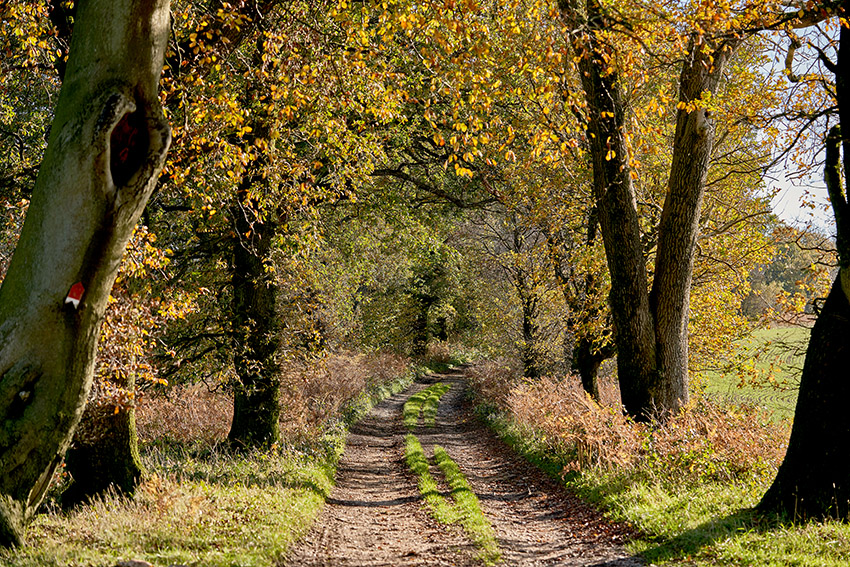
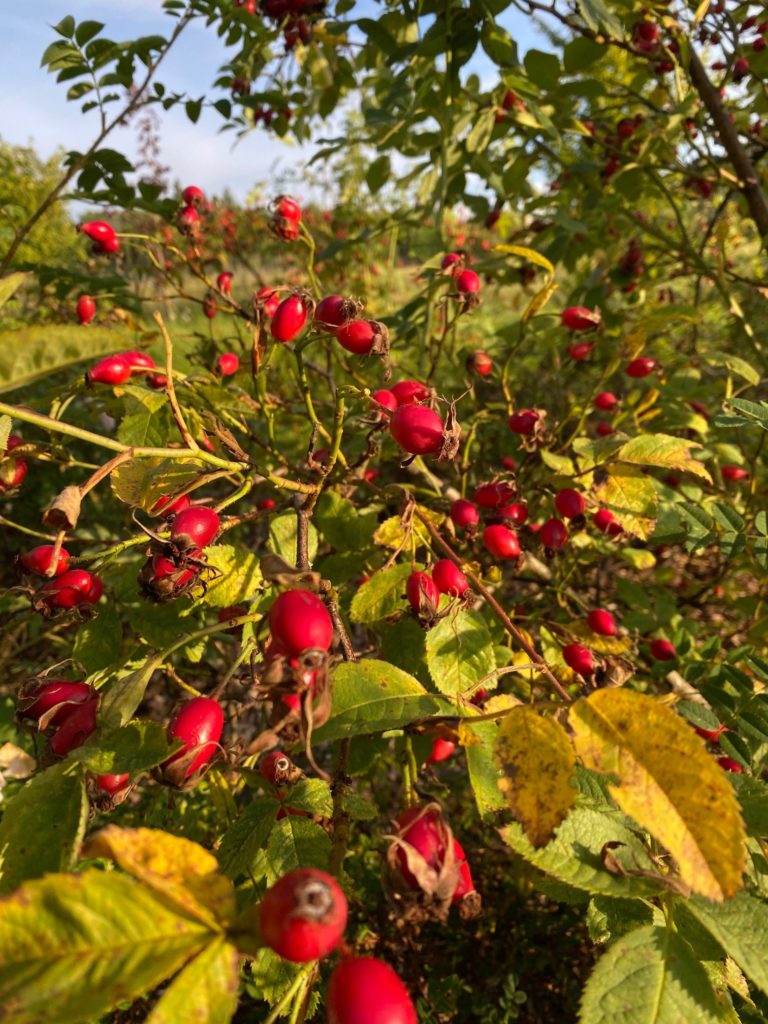 Walking through the Secret Garden with a friend, we stopped by a large old rose overflowing with orange hips. She picked one, pulled it apart to take out the seeds and ate the remaining orange hip, taking advantage of how rich rose hips are in vitamin C. (Please only try this if you know it is a rose hip!) Of course, I immediately did the same, wanting the same benefits, and we swopped stories about what we can collect to eat at this time of year.
Walking through the Secret Garden with a friend, we stopped by a large old rose overflowing with orange hips. She picked one, pulled it apart to take out the seeds and ate the remaining orange hip, taking advantage of how rich rose hips are in vitamin C. (Please only try this if you know it is a rose hip!) Of course, I immediately did the same, wanting the same benefits, and we swopped stories about what we can collect to eat at this time of year.
As a child I loved rose hip syrup, a recipe for which I have shared in my new book “Seasons at Highclere”. The other drink I loved was “Ribena” which is made from blackcurrants. Equally good though are elderberries, hanging in dark umbrellas alongside many paths at this time of year. Traditionally, elderberries help combat fever and rheumatism and make the most delicious syrup but must not be eaten raw. Today, it is most often taken as a supplement to treat cold and flu symptoms.
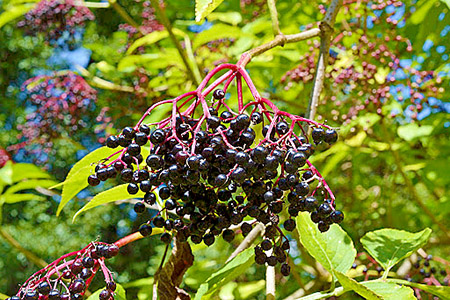 If you want to make an elderberry cordial, collect the berries and strip them with a fork into a large saucepan, adding enough water to cover the fruit. Simmer for 15-20 minutes and strain through a piece of muslin. Add a squeeze of lemon juice and 500g of sugar to each litre of the liquid and bring to the boil again. Once the sugar is dissolved completely and the mixture is syrupy, take off the heat and allow to cool. Pour into sterilised bottles and store in the fridge. It can be diluted to taste as a cordial or try a teaspoon neat to get a little vitamin boost in the colder months. In darker months of the year, it is packed with anti-oxidants as well as vitamin C which helps your immune system mitigate inflammation and stress.
If you want to make an elderberry cordial, collect the berries and strip them with a fork into a large saucepan, adding enough water to cover the fruit. Simmer for 15-20 minutes and strain through a piece of muslin. Add a squeeze of lemon juice and 500g of sugar to each litre of the liquid and bring to the boil again. Once the sugar is dissolved completely and the mixture is syrupy, take off the heat and allow to cool. Pour into sterilised bottles and store in the fridge. It can be diluted to taste as a cordial or try a teaspoon neat to get a little vitamin boost in the colder months. In darker months of the year, it is packed with anti-oxidants as well as vitamin C which helps your immune system mitigate inflammation and stress.
Autumn brings an abundance at this time of year, from crab apples to medlars, plums, sloes, blackberries, greengage’s and, of course, apples, both for eating and for cooking. 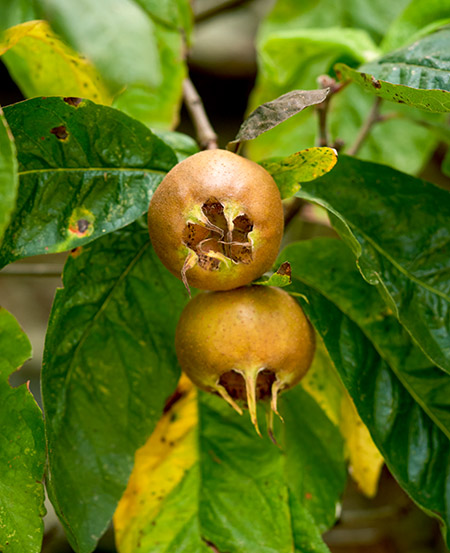 Many of these fruit trees do well growing up against the walls of a house so need not take much space. If you plant one, add a clematis or honeysuckle at the base for a little extra colour and pleasure. They also have the considerable advantage of being less prickly than roses when you come to pick the fruit.
Many of these fruit trees do well growing up against the walls of a house so need not take much space. If you plant one, add a clematis or honeysuckle at the base for a little extra colour and pleasure. They also have the considerable advantage of being less prickly than roses when you come to pick the fruit.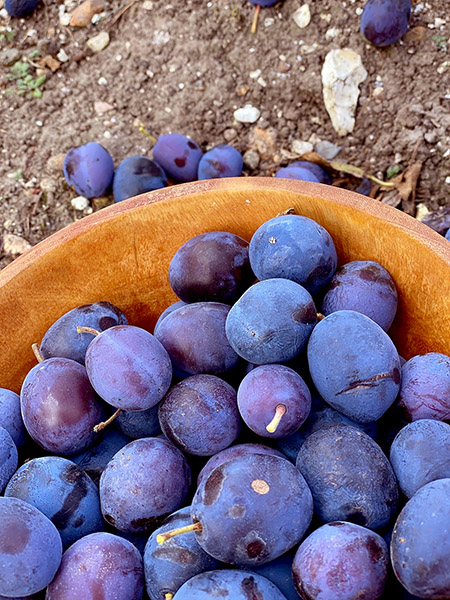
Foraging has become rather a trendy word over recent years but in the past it would simply have been a way of life, something that everyone did simply as a matter of course. It is immensely satisfying, whoever you are, to gather what is essentially free food. However, as with all things, common sense and care is key.
 This is particularly important with mushrooms which are another food abundant at this time of year. However much you may admire them nestled under trees or scattered in fields, please buy them from a shop as most of us do not know enough about what to pick and what not to pick and some of them are in fact deadly. However, field mushrooms, shitake, oyster and chestnut mushrooms are safe, seasonal and entirely easy to buy. They are just delicious: grilled, baked, sautéed, used in casseroles or raw in salads and extremely good for you. Rich in selenium, potassium, copper and vitamin B’s, they are also the only food source of vitamin D. Therefore they help our immune system, regulate blood sugar and support efforts to reduce the risk of type 2 diabetes.
This is particularly important with mushrooms which are another food abundant at this time of year. However much you may admire them nestled under trees or scattered in fields, please buy them from a shop as most of us do not know enough about what to pick and what not to pick and some of them are in fact deadly. However, field mushrooms, shitake, oyster and chestnut mushrooms are safe, seasonal and entirely easy to buy. They are just delicious: grilled, baked, sautéed, used in casseroles or raw in salads and extremely good for you. Rich in selenium, potassium, copper and vitamin B’s, they are also the only food source of vitamin D. Therefore they help our immune system, regulate blood sugar and support efforts to reduce the risk of type 2 diabetes.
My favourite breakfast is to sauté them with some butter and herbs such as thyme or parsley served either with a slice of toast or on their own (I am trying not to eat bread with every meal and mushrooms have zero carbohydrate). “Seasons” also has a satisfying recipe for a mushroom lasagne and it becomes gluten free if you use the gluten free lasagne. Serve it with a large green salad tossed with a mustard vinaigrette.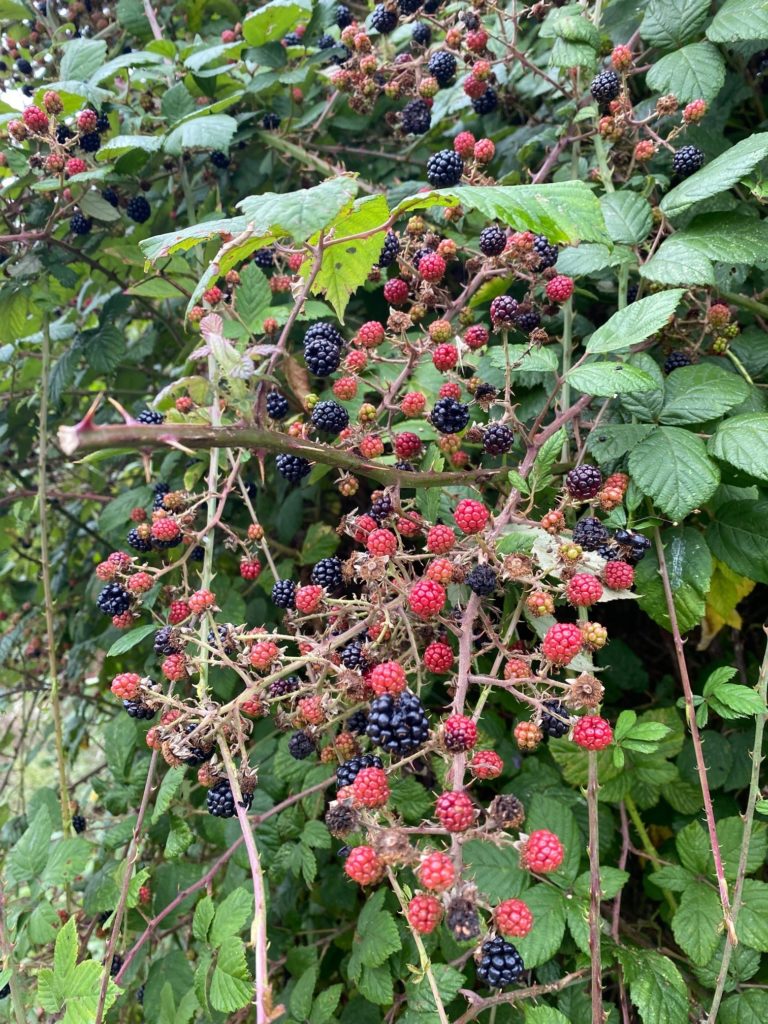
A very easy foraging option is to enjoy a walk along old downland tracks or by woods and take a basket or a bag to eat and pick some blackberries. Choose the ones higher up (clear of dogs!) and make a cake or stewed blackberries on porridge for breakfast, make some frozen blackberry yoghurt or blackberry and apple crumble. It is a fun family occupation.
Our ancestors gave more time in each day to walking for a purpose, for doing and collecting, to pick and to store. “To every thing there is a season, and a time to every purpose under the heaven:…. a time to plant, and a time to pluck up that which is planted.” 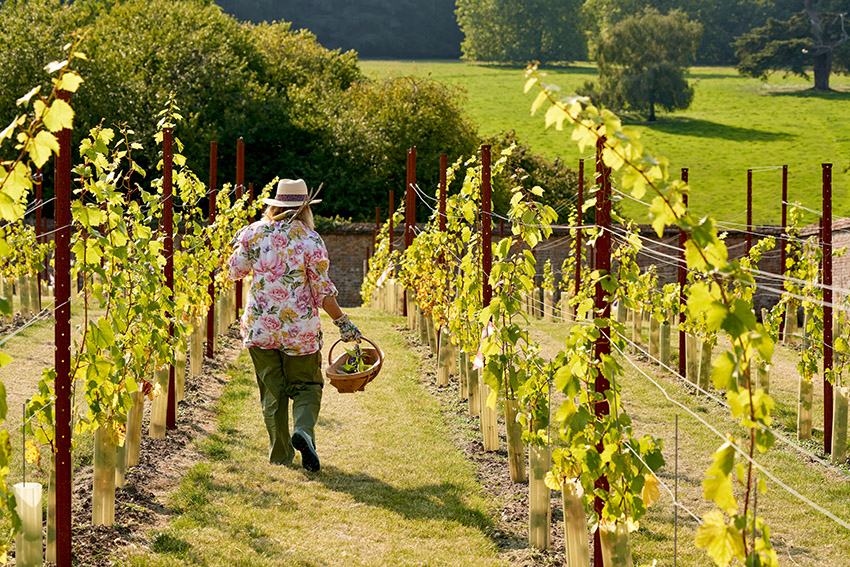
I think walking and collecting gives me moments of peace and the aim is not to eat it all straightaway! That is the challenge.








 Instagram
Instagram
Thank you, Lady Carnarvon, for reminding me that it’s the simple things in life that bring the most pleasure.
Lady Carnarvon my mouth is watering after reading your blog this morning. Picking fresh berries and making something sweet from them is so satisfying in more ways than one. Wish I had an apple crumble to go with my coffee this morning.
Enjoy your meals today,
Pam
What peaceful and lovely pictures this conjured in my mind!
I wasn’t aware of how nutritious mushrooms are! Thank you for all of the useful ideas!
Kathryn Crowell
North Carolina, USA
Thank you!
Lady Carnarvon pictures of fruits of forest thank you for the email did you have a nice weekend and lord Carnarvon l lovely to visit highcelere castle
Thank. you so much – it was a busy weekend…
My dear Lady Carnarvon,
Thank you once again for an interesting & educational blog. Unfortunately I live in a town with no access to lovely things growing in hedgerows & on bushes, but you’ve given me ideas as to what to buy in the local shops, when available.
I wish you & everyone at Highclere a very safe & happy Autumn,
Love, Caroline x
Absolutely – mushrooms!
Oh how I miss going out and picking blackberries from the back lanes. They just taste better than cultivate ones. Memories of my mum’s apple and blackberry crumble with clotted cream still remain clear in my mind. Sadly here in the USA opportunities to go out and find free food are not abundant so I dream of beautiful autumn english days. Lived here for 25 years and still miss those September days.
Thank you for the amazing pictures and giving me a chance to remember.
My grandmother use to make elderberry wine. From what I understand you could get a good buzz from it. Beautiful garden thank you for listing us see it.
fondly Jenny
Hello Lady Carnarvon.
Nice photos. I know you like a challenge. Are you visiting Chelsea for inspiration?
We are … love it
When my 4 children were young there never seemed to be enough of anything, especially money for extras, so we did a lot of foraging on weekends along secondary country roads. Back then there was an abundance of elderberries, raspberries and blackberries, black walnuts, apples and pears that had fallen from trees, grapes growing wild, and all on roadsides owned by no one but Mother Nature. Even asparagus in the spring, and wonderful watercress fresh from spring ponds. My children never had store-bought jams and jellies, or baked goods that I hadn’t made myself. We weren’t poor but we certainly enjoyed our time spent foraging, and the rewards were sweeter from our efforts.
I think so too…
Kathy’s letter reminded me so much of my childhood when my mother took me to pick blackberries in the woods…. She made me wear long shirts so that my arms wouldn’t get pricked by blackberry thorns. It was too warm in those shirts, but worth the sweet taste of blackberries among the bushes near our home in Virginia. Sweet memories!
Martha G.
Lovely photos and ‘tour’ of the gardens. Autumn brings such beauty which is a joy to all the senses! Thank you for sharing!
Greetings again Lady Carnarvon,
Thank you for another lovely, informative and enjoyable blog to read while beginning our day! Amazing that you have so many fields of expertise as you sound like and expert nutritionist in this blog!
Living in the northeast of the USofA I loved cooking & baking according to the season with ingredients ripening during spring, summer and fall and of course canning many during those seasons to utilize throughout the winter months.
Agree with you that foraging can be peaceful and calming as long as there are an abundance of items to pick (high up! LOL) and not many among thorns. Hope yours are plentiful. Agree that Autumn is a favorite and beautiful season (especially there at Highclere). Carry on and remain well!
thank you so much !
Brings back memories of walking along the Cornish paths picking blackberries with my young boys. Mumbles and grumbles at times “why do we have to walk everywhere?” but they gobbled up the blackberry and apple pies with Cornish clotted cream pretty swiftly.
It is just the first few minutes setting off and then grumbles recede.. I found anyway
Dear Lady Carnarvon;
I am writing from PEI, Canada and have been following your blogs for years, now and have enjoyed every one immensely! They have kept me very cheerful throughout these last months. Thanks so much for the education in foraging today! You have encouraged me to go out and find new things! Thanks for sharing your home and so many parts of your life with us!
Cheers and blessings
Marilyn
Dear Lady Carnarvon,
Your Monday morning contemplations and musings are so much appreciated by this urban forager. Fresh from the farmer’s market, I’m enjoying a lovely morning latte, which I foraged from the kitchen. Too many times my poor cup is left behind, as the day’s pursuits cascade. One, two, and the sad third trip to the microwave do nothing to improve the flavor nor the day. Each Monday morning up pops the promise of a few minutes of peaceful meandering for me and my latte. So I do intend to drink “it all straightaway. That is the challenge.” Thank you.
Suddenly I’m 12 years old again, living near my Grandparents’ farm!
Hot muffins with homemade butter and plenty of elderberry jelly on a cold winter morning – the best treats are those only nature can provide!!
A delicious read! Is there anything better than blackberry cobbler? My grandmother made it as blackberry dumplings.
they are delicious!
Living in the southern part of the United States, our garden is dwindling, as are our hedgerows. We gathered blackberries in July! They remind me of hot summer days gathering buckets and buckets of blackberries on the side of country roads. We sweltered, but the reward of a cobbler for dessert was worth it! Our wilted sunflowers and dogwood berries are attracting the finches of all colors right now, and we are amused by the hummingbird battles as they fuel up for their migration. Although autumn brings us just marginally cooler weather (we still see 30 degree weather into October!), it is my favorite season!
It is a lovely season! We have been hearing of the efforts to save the sequoias..
Lady Carnarvon,
Thanks for another story full of sweet summer country backroad memories. I have frozen blackberries – time for a late September blackberry cobbler!
Martha G
Sounds delicious!
Lady Cavernon
I know very well the felling of walking around the fields, take the fruit that is left on the trees… pick blackberries… come home and make jams! I live in a big city but returning to the countryside, especially at this time of year, is a unique feeling of serenity and comfort! And also the colors are extraordinary!
The magic of colors and aromas happens!!!
Lady Carnarvon, your stories are always the very best. It is always a joy every Monday morning. Happy Autumn to you and all.
Thank you and to you too
Your hint about not picking the low hanging fruit—written as only a dog owner could.
Happy Monday!
I really enjoyed reading your blog today! It brought back wonderful memories of not only my childhood but of our last trip to England. It was then that I first tasted Elderflower Cordial. I had to try it because my Father took us searching the countryside for Elderberries every year. Mom made jelly with the fruit. It was SO delicious. But I had never had the cordial. It was really tasty! I am aware that the lovely white flowers are also used to make things. That is new to me.
Our last visit was to attend Heroes at Highclere. What a wonderful event. I thank you again for organizing it.
Happy foraging!
Sue Smith
Thank you – I am just orchestrating a weekend around that theme this October – smaller but fun and meaningful Oct 9 and 10
Adored this article and this time of harvest
Lady Carnarvon,
I don’t think we give enough credit to those who use natural products to heal. Wouldn’t it be amazing if natures’ bounty could provide a cure for Covid?
I think the human response has been exceptional and alongside that we all need to stay healthy
Dear Lady Carnarvon,
That blog was utterly fabulous. I’m so enjoying all the hard work and research you put into this. (I’ve seen you on television but you visualize everything equally well with narrative and those beautiful still shots!).
Thank you so much …
Dear Lady Carnarvon,
Your photography is amazing. I feel as though I am right there. Thank you.
Have a wonderful day.
You are kind!
What a mouthwatering blog!
I also love the “eye candy” of your perfect photos that I can enlarge!!! What is the fruit with the pointy bottom? This fruit is new to me.
This blog reminded me of picking and eating Concord grapes from my Grandmother’s arbor.
Happy Autumn to everyone.
Cheers
Shelley in Virginia
Crab apples !
“To every thing there is a season, and a time to every purpose under the heaven:…. a time to plant, and a time to pluck up that which is planted.” Is one of my favorite Scriptures and one that comforts us when the time comes to need it. Your postings always are so heartwarming and down to earth. Thanks for sharing the wonderful thoughts, photos and memories with all of us.
Those lines are inscribed on a sundial here … the Bible lines have such rhythm and cadence
This letter brought back childhood memories of weekend foraging for morels in season with my beloved father on my maternal grandparents home in the country. He was EXPERT at finding them, especially the little tender ones. My favorite childhood morel dish: Dredged in flour seasoned with salt and pepper and then fried. My mouth is watering just remembering …. Thank you!
Lady Carnarvon., The photos of your secret garden are BEAUTIFUL. They brought back memories of my visit to your estate. Would lobe to visit again some day. Best wishes to you and your family. Stuart D. Ward
I love the gardens
Dear Lady Carnarvon:
Thank you for your “tasty” Monday blog, the colorful pictures, and sharing a recipe or two.
Will the October event be presented live on Facebook or Instagram?
Until next week, keep foraging and walking.
Perpetua Crawford
Thank you – I will hopefully stream it on both plus we may have some press and TV here
Dear Lady Carnarvon,
Talking about mushrooms I will share with you a lovely and very simple recipe that I invented with raw mushrooms, preferably white mushrooms, the kind one gets in the supermarkets. You peel their skin, and cut them in lovely size-pieces. Then grind into smaller pieces with a knife or your hands if they are fresh, some walnuts and cut half an onion into small pieces too. You mix the three ingredients: mushrooms, walnuts and onions and lavish them with normal oil, lemon juice and sea salt. Toss and serve. You can keep this cold salad in the fridge for at least 3 days. Although I doubt it will last the first time that long once you serve it.
That sounds delicious and I love collecting walnuts!
Good afternoon.
I am very much looking forward to receiving your latest book. It will arrive about time for my birthday, so it is going to be doubly special.
I do look forward also to your weekly writing. Although you don’t think you and your husband lead such interesting lives, to those of us living in the suburbs of minor cities, it is a world apart.
I also look forward to coming and seeing Highclere in the next year.
As always good health to you and your family.
Sincerely,
Jayson Lambert-Roszak
You are very kind and I will be so interested to hear your thoughts about Seasons. It has been layers as ever!!!
Dear farmer Lady Carnarvon,
Delicious reminders of childhood treats like Crab Apple Jelly, Rose Hip Jam, Blackberries for
Cobblers (remember to take gloves when you go foraging for them), Mushrooms (who love garlic with them). You should never ever peel mushrooms they lose a lot of moisture if you do….just wipe them over with a paper towel and store them in a brown paper bag in the cupboard for 2-3 days. and never in the refrigerator. I love mushrooms and would have them on my cereal if I could find a way to do it 🙂
We also found wild garlic, dill, sometimes asparagus and occasonally wild strawberries.
Unfortunately the paddocks to roam around and the laneways to walk along are mostly now houses and roads but my memories are just as fresh as the free produce was.
We are back in lockdown AGAIN and the highlight of my day is the greeting from my postman as he delivers the mail complete with mask on. Hopefully…..hopefully we will be back to normal next week and I am first in line for a haircut (if I can get in front of all the others) and a visit to the library. We are very fortunate here as our supermarkets and chemists have been delivering our goods to the door for months now and that has been an enormous help. Still I should not complain, I am still on the topside of the grass and feeling quite well 🙂
Best wishes to all our lovely chatters and God Bless you Lady Carnarvon for your wonderful uplifting blogs, you certainly have brightened my days 🙂
Joy Roebig
Australia
Sorry to hear you are back in lockdown!
Dear Lady Carnarvon:
I loved your delicious “chat” about all the edible wilds around you. But no one mentioned using elderberries for pie! My Mom always made the most delicious elderberry pie…looks like a blueberry pie, sort of but you need zillions of elderberries to make one. But worth the time collecting them. We always found them in deep ditches in the countryside in Ontario, Canada. Elderberry pie beats blueberry pie hands over!
Yes I do want to make an elderberry cordial. Thank you for the recipe.
And now I’m quite inspired to get out to our nearby abandoned army outpost here in central Oregon where there are apple trees by the hundreds. We can go and forage to our hearts content, then come home to make a new batch of applesauce to can and then store in the pantry.
Regardless of the bounty, the walk is always enjoyable.
Thank you for sharing the cordial recipe. It sounds delightful.
Lovely, and it all brought back so many happy memories of my childhood life in the country, how I miss it. There is nothing to compare to field mushrooms gathered while the dew is still on them and cooked in butter for breakfast. Yummy .
And please forgive me but surely the ‘pointy bottomed fruit, that a reader inquired about, are medlars? We used to stuff ourselves with them as children but I haven’t had one for years now.
MY DEAR LADY CARNARVON,
RÍO CLARO – SP – BRAZIL -37°CELSIUS
GOOD EVENING
WHEN WILL WE HAVE A WEBCAM IN HIGHCLERE CASTLE, MEADOWS AND GARDENS ?
LOVELY WORDS.STUNING PHOTOS. BEST WISHES FOR YOU AND YOUR STAFF.
CONGRATULATIONS FROM BRAZIL FOR YOUR NEW BOOK. BEAUTIFUL WEEKEND FOR ALL.
VILLA ALEMÃ
RIO CLARO- SP
BRAZIL
I will not have a web cam. It is still my home!!! However I have a fun project Friends of Highclere https://friendsofhighclere.com/
SO SORRY MILADY,REALLY IT’S YOUR HOME, SO SORRY,SORRY.
Please don’t worry – I think we all have enough cameras looking at us and I am not sure they make for happiness!
Lady Carnarvon lovely pictures of fruits of the forest and lovely to highcelere castle and l have your books they are very good and l have work for 30 years
Lady Carnarvon, just clicked on the link to friendsofhighclere.com. Looking forward to the annoucement. It does sound so exciting! Best Wishes To You, Cheryl.
Dear Lady Carnarvon
This is just such an interesting blog and find lots of lovely things to read in it
Dear Lady Carnarvon,
I bought a house in 2018 here in Alabama and it came with roughly 10 acres of land. Much to my pleasure, I discovered we had wild blackberries growing in certain areas on the property. Our picking season is from late June into July – I always take the dogs with me to flush out snakes, but they enjoy the ripe berries as much as I do.
I am hoping to get an impregnated mushroom log and leave it in our more shadowed section of the land. We have some tall pines in the back of the house that would be perfect for them.
Thank you for the elderberry cordial recipe! I have seen where they have become more popular in recent years for flu symptoms and I’m hoping to start a section next spring. I’d also like currants. So many plans and so little time! Your blog reminds me of when I was younger and in the woods almost daily. We had plum trees, a pecan tree, and some hickory trees in the neighborhood.
Dear Lady Carnarvon!
Your story brought out a memory of my great-grand mother(born 1870.)She had twelve children and became a midwife/dula to many women. She knew herbs and remedies. Her first lesson to any woman was : “Take off your hat in front of every wild rose bush and kneel and bow your head in front of elderberry.”
Thank you for such a wonderful vivid and fragrant reminder of my autumns with her.
Elizabeth
MY DEAR LADY CARNARVON ,
BONJOUR MADAME,
L’AUTOMNE—- VICTOR HUGO. TOUT LA LYRE
L’AUBE EST MOINS CLAIRE. L’AIR MOINS CHAUD, LE CIEL MOINS PUR;
LES LONGS JOURS SONT PASSÉS, LES MOIS CHARMANT FINISSENT.
HÉLAS! VOICI DÉJÀ LES ARBRES QUI JAUNISSENT!!…
L’AUTOMNE EST TRISTE AVEC SA BISE ET SON BROUILLARD,
ET L’ÉTÉ QUI S’ENFUIT EST UN AMI QUI PART.
SALUT POUR TOUT LE MONDE.
,
.
Beautiful words
Dear Lady Carnarvon,
Thank you again for a wonderful blog. My rose hips 7+acres of them are the source of sustenance for all of us and the wildlife here in Montana. The deer- horses- and we love them. Harvesting more today to make precious tea! Will have to get the Seasons book in order to get the syrup.
Thank you again! So wonderful to be able to live off all you have right in front of you! Need to plant some black currants- yet another favorite with the huckleberries, raspberries, and blackberries!
Best to you and yours as this harvest season envelopes us.
Iris B